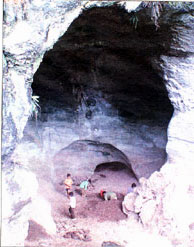Traces of a road used by ancient people 21,000 years ago have just been discovered at the Xom Trai Cave in the northwestern province of Hoa Binh's Lac Son District.

Scientists from the Centre for Southeast Asian Prehistory recently made the discovery during an on-going preservation project at the site.
"This is the first discovery of such an ancient road in the Southeast Asian region and a rare discovery in the world," Nguyen Viet, PhD, centre director told Viet Nam News. The Xom Trai Cave represents a typical residence of the Hoa Binh civilisation (from 34,100 years ago until 2,000 BC) in the ancient Muong Vang region, which is today's Tan Lap Commune, Lac Son District in Hoa Binh Province.
The cave was discovered in 1974 and went through various stages of excavation in 1981, 1982, 1986 and 2004. The Ministry of Culture, Sports and Tourism listed it as a national archaeological relic in 2005.
The Hoa Binh Museum has coordinated with the centre to preserve the relic since 2004. Since then, researchers have discovered traces of approximately six metres of a road at the south end of the cave's mouth. The ancient pathway lies 60-70cm deeper than the Hoa Binh civilisation layer. The traces are believed to date back 8,000-9,000 years ago and remain in good preserved condition.
Another four metres below the Hoa Binh civilization layer, a route presumed to be used by the earliest cave dwellers has also been discovered. The route had been hidden by several layers of stones and debris that have fallen over time due to landslides and other geological events. Also, portions of the route have been covered by hard water resulting from rain water and local limestone.
One month ago, researchers discovered 10 m of another route linking the cave's mouth to the foot of the mountain.
The excavation has also uncovered a tomb from about 17,000 years ago. The remains were buried in the typical style of the Hoa Binh civilization, leaning towards the right with legs folded. The body's hips were placed over 25 cm of coal and the tomb was covered with soil and large stones. An oval pestle, two carving tools and a horn pointed hook were buried with the remains.
Many human bones had been found scattered about the cave before the complete tomb was discovered.
"Six clear traces of the road are being solidified by hard water", Viet said. "It is likely that more traces will be found. A larger number of worn-out stones indicate that the newly discovered road was used more often and for a longer period of time than the route at the southern end of the cave's mouth. I guess the route was used between 10,000 and 21,000 years ago."
The researchers plan to make silicon moulds of the traces and preserve them using the most modern techniques.